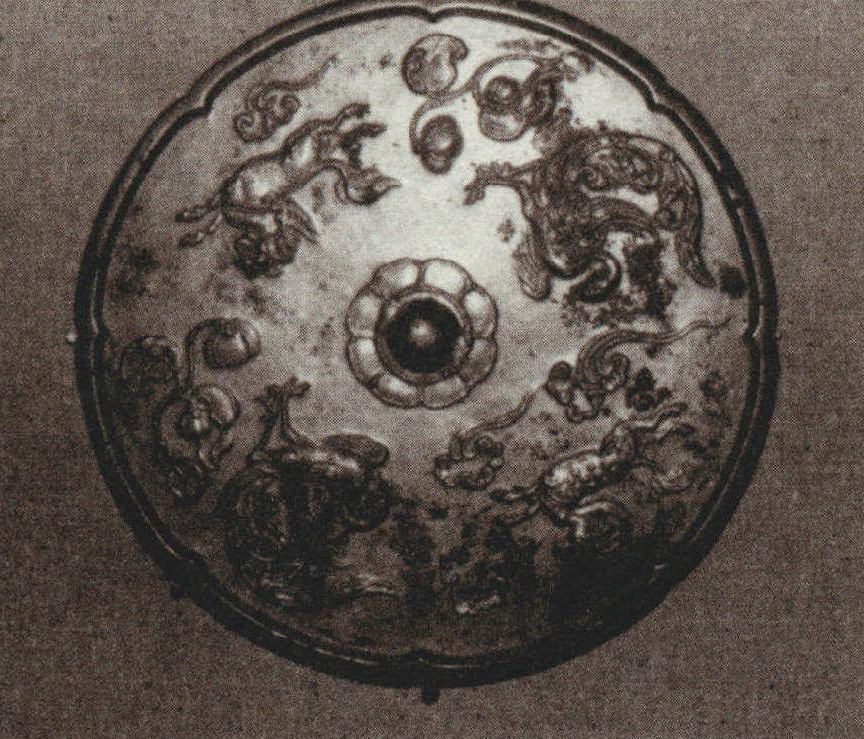皇甫枚(生卒年月不详),唐末文学家。字尊美。汉魏时期皇甫家族后裔。祖籍安定郡朝那县 (今宁夏彭阳)。唐代三水县(今宁夏同心境内)人。活动于唐武宗至五代初 (841~911),七十岁左右去世。咸通年间 (860~871),任汝州鲁山县(今河南鲁山)县令。咸通十三年(872),曾居住在洛阳敦化里。次年,由汝州 (今河南临汝)到陕西郑县(今陕西华县)暂住,后曾返回故乡三水县生活过一段时间。唐僖宗李儇南逃梁州 (今陕西南郑)时,慕名召见过他。唐末天祐年间 (904~905),又流落到山西。
李唐王朝灭亡,五代朱梁政权建立以后,皇甫枚仍然“心系本朝,宁投草莽而不忍为梁之臣仆” ,因此,他继续坚持使用唐朝年号、纪年,以表“不妄故主” 的心迹。这一时期,他两耳不闻窗外事,闭门专心写作,“追记咸通时事” ,精心创作出一部传奇小说集《三水小牍》(上下卷),以寄托一个亡国老臣的思想感情。由于他效法古人,不食“梁粟” ,最后因贫病交加而“终老汾晋” 。

唐代葵边鸾兽镜
Phoenix and Beast mirror with Sunflower marge (Tang Dynasty)
《三水小牍》 一书,在我国历代目录学著作中基本上多有著录,如《新旧唐书·艺文志》 《宋史·艺文志》 《太平广记》 《文献通考·经籍考》、明《古今说海》、清《抱经堂丛书》《天一阁书目》和鲁迅选辑的《唐宋传奇集》、汪辟疆校录的 《唐人小说》等,都加以收录和介绍。《三水小牍》中的代表作,公认为是:《王玄中》 《王知古》 《步飞烟》 《缘翘》 《却要》 《王公直》和《温京兆》七篇。皇甫枚的《三水小牍》在唐代传奇中占有重要的地位,反映了当时的社会现实生活,触及唐末存在的一些重要社会问题,具有深刻的社会意义,也反映出作者具有进步思想的倾向。《三水小牍》的内容 “多纪仙灵怪异,而每及义烈,亦复凛凛有生气。是于侈陈灵异之余,隐寓垂诫之旨。至文辞雅饰,不失唐人规范,又未可以以猥琐诞妄视之也” 。其写作技巧亦有自己的特色,长篇文辞浮艳,骈散相间,往往插入律绝,以诗代简,巧妙地起到传情作用,给读者一种美的享受;有的短篇寥寥数行,粗陈梗概,却具简明情节和完整结构,同样引人入胜。它比六朝志怪小说前进了一大步,对宋以后的话本小说产生过较大的影响。因此,皇甫枚其人其作,在中国文学史上占有重要的地位。
Huangfu Mei (birth date and death date unknown),a writer in the last years ofthe Tang Dynasty (618-907),styled himself as Zunmei. He was a descendant of the Huangfu family in the Han and Wei Dynasties. His ancestral homewas in Zhuna County in Anding Prefecture (the present-day Pengyang in Ningxia),and a native of the Sanshui County in the Tang Dynasty (the present-day Tongxin County in Ningxia). He was active during the ruling period of Emperor Tang Wuzong and the early tears of the Five Dynasties period (841 A.D.-911 A.D.) and died when he was about 70 years old. In the Emperor Xiantong period (860 A.D.-871 A.D),he took the post of the County Magistrate of Lushan County (the present-day Lushan in Henan Province) in Ruzhou. In the thirteenth year of Xiantong (872 A.D.),he lived in Dunhua Li in Luoyang. In the next year,he moved from Ruzhou (the present-day Linrun in Henan province) to the County of Zhen in Shaanxi (the present-day County of Hua in Shaanxi Province) and lived there temporarily. Later he moved back to his hometown Sanshui County again and lived there for a period. When Li Xuan,Emperor Tang Xizong,escaped southward to Liangzhou (the present-day Nanzhen in Shaanxi Province),he called in Hangfu Mei out of his admiration for him. In the ruling time ofTianyou in the last years of the Tang Dynasty(904-905),Huangfu Mei led a wretched and wandering life again in Shanxi Province.
After the downfall of the Liang Dynasty in the Five Dynasties period with Zhu's ruling,Huangfu Mei was still "loyal to the Tang Dynasty,and would even give in to those greenwood heroes rather than becoming the subject or official of the Liang Dynasty". Therefore,he continued using the reign titles and the annals of the Tang Dynasty to show his loyalty to the former emperors. During that period,he shut his two ears to what was going on outside his house and just concentrated his mind on writing at home. As a result,by recollecting the current events in Emperor Xiantong's time,he composed a literary tales collection of "Sanshui Xiaodu" with two volumes to express his deep affection as an old official of a conquered state to his nation. He died of illness and poverty in Fenjin,following suit of the ancient people refusing to eat "the maize of the Liang Dynasty".
The book "Sanshui Xiaodu" had been recorded and introduced in most bibliographic works in the past dynasties of China,for example: " Works of the New and Old Tang Dynasty · History of Arts and Literature","History of the Song Dynasty
· History of Arts and Literature","Extensive Record of Taiping","A Thorough Survey of Documents · Survey of Confucian Classics","Ancient and Present-day Accounts of the Sea" in the Ming Dynasty,"A Series of Bao Jing Tang" in the Qing Dynasty,"A Booklist of Tian Yi Ge","the Tales Collection of Tang and Song Dynasties" selected by Luxun,as well as "Novels about People in the Tang Dynasty"proofread and recorded by Wang Pijiang and so on. The following seven pieces were generally acknowledged as the masterpieces of "Sanshui Xiaodu": "Wang Xuan Zhong","Wang Zhi Gu',"Bu Fei Yan","Yuan Qiao","Wang Gong Zhi" and "Wen Jing Zhao".The book "Sanshui Xiaodu" took an important position in the literature tales of the Tang Dynasty. It not only reflected the actual social reality and life at that time,disclosed some important social problems in the last years of the Tang Dynasty and thus had a deep significance to the society,but also reflected that the author himself had borne some advanced thoughts at that time. The content of the book "mainly focused on the descriptions of celestial beings,spirits and monsters. But whenever there were descriptions about the staunch and upright,the author gave them lives and made them awe-inspiring. Between the lines describing the spirits and monsters,the author implied his admiration and respect for honesty. The style and rhetoric devices applied by the author in this book are also typical of the Tang Dynasty and can not be neglected,despised or regarded indecently". The author had his own writing skills characterized by a combination of long pieces with well-polished words,alteration of parallel style and plain prose style,insertions of regulated verses of five syllables or seven syllables,and short poems,conveying the author's feelings skillfully and giving the readers a sense of beauty and short to several-lined pieces characterized with rough but brief plots and complete structures,which are similarly attractive. His works had achieved greater progress as compared with the tales of mystery and the supernatural in the Six Dynasties period,and exerted a fairly great influence on the colloquial stories after the Song Dynasty. Therefore,both Huangfu Mei,the author himself,and his works took an important position in China's literature history.Ⓔ
本文地址: https://www.yishiweijian.com/renwu/2022123835.html
文章来源:主编
版权声明:除非特别标注,否则均为本站原创文章,转载时请以链接形式注明文章出处。
2023-02-15主编
2023-02-15主编
2023-02-15主编
2023-02-15主编
2023-02-15主编
2023-02-15主编
2023-02-15主编
2023-02-15主编
2023-02-15主编
2023-02-15主编
2022-11-29主编
2022-11-29主编
2022-11-23主编
2022-11-18主编
2022-12-08主编
2022-12-08主编
2022-12-02主编
2022-11-29主编
2022-11-29主编
2023-01-03主编
2022-12-02主编
2023-01-24主编
2022-11-17主编
2022-11-18主编
2023-02-15主编
2022-12-31主编
2023-01-03主编
2023-02-15主编
2023-01-03主编
2022-11-19主编
扫码二维码
获取最新动态
